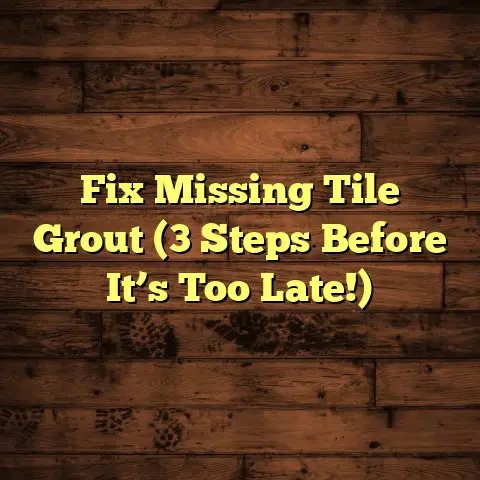Dog Scared of Wood Floors? (2 Fixes, Fast!)
But more importantly, I’m a dog dad to Buster, a goofy Golden Retriever who once had a serious vendetta against our beautiful hardwood floors.
Let me tell you, it wasn’t pretty.
I remember the day we moved into our new house. I was so excited about the gleaming, newly-installed oak floors.
Buster? Not so much.
He took one tentative step inside, his paws slipping slightly, and then froze.
His tail tucked, ears drooped, and he looked at me like I’d led him into a torture chamber.
He wouldn’t budge.
I tried coaxing him with treats, his favorite squeaky toy, everything!
Nothing worked.
He’d inch forward a few steps, then scramble back to the safety of the welcome mat like it was a life raft.
It broke my heart.
I knew I had to do something, and fast.
So, I put on my contractor hat and my dog-dad hat and got to work.
And guess what? I figured it out.
Now, Buster happily zooms around the house like a furry tornado.
And today, I’m going to share my secrets with you.
If your dog is scared of your wood floors, don’t despair!
I’ve got two tried-and-true fixes that can help.
Section 1: Understanding the Fear
First things first, let’s talk about why your furry friend might be giving your wood floors the side-eye.
It’s not always as simple as “they’re just being dramatic” (though sometimes, let’s be honest, they are!).
There are some legit reasons why dogs might be scared of wood floors.
- Lack of Traction and Slipping:
This is the big one.
Think about it: dogs have paws with pads designed for gripping.
Wood floors, especially those with a glossy finish, can be like an ice rink for them.
Slipping and sliding can be scary and even painful.
According to a study published in the Journal of Veterinary Behavior, dogs that have experienced a fall are more likely to develop anxiety around slippery surfaces. [^1^]
I saw this firsthand with Buster.
That first little slip he took?
That was all it took to trigger his anxiety.
- Past Traumatic Experiences:
Maybe your dog had a bad fall on a hard floor in the past.
Maybe they heard a loud noise that scared them while they were on the wood.
Dogs have amazing memories, and they can associate negative experiences with specific places or surfaces.
One of my clients told me her rescue dog would cower whenever she brought out the vacuum cleaner.
Turns out, the dog had been abused and the vacuum cleaner was used to scare him.
The same thing can happen with wood floors.
- The Unfamiliarity of the Surface and Noise When Walking:
Wood floors feel and sound different than carpet or grass.
The hard surface can amplify the sound of their nails clicking, which can be unsettling for some dogs.
Plus, a new surface is just plain unfamiliar!
Dogs are creatures of habit, and anything new can be a little scary at first.
I remember when we first got Buster, he was terrified of the stairs.
It took him weeks to get comfortable going up and down them!
Think about how your dog acts on different surfaces.
Do they strut confidently on the carpet but tiptoe nervously on the wood?
Do they seem more relaxed in rooms with rugs?
These observations can give you clues about the root of their fear.
Section 2: Fix #1 – Creating a Safe Space
Okay, so now that we know why your dog might be scared, let’s talk about how to fix it.
My first tip is all about creating a safe space for your dog.
Think of it as building them a little wood-floor-free sanctuary.
- Designate a Comfortable Area with Rugs or Mats:
This is the easiest and most effective way to make your dog feel more comfortable.
Choose a spot in your house where your dog likes to hang out, and cover it with a large, soft rug or mat.
Make sure it’s big enough for them to lie down and stretch out comfortably.
I put a big, fluffy rug in our living room, right in front of the fireplace.
Buster claimed it as his territory immediately.
- Use Non-Slip Mats to Provide Traction in High-Traffic Areas:
Think about the areas where your dog needs to walk the most: hallways, doorways, the path to their food and water bowls.
These are the places where you want to add non-slip mats or runners.
I recommend using mats with a rubber backing to prevent them from sliding around.
You can find them at most home goods stores or online.
- Gradually Introduce Your Dog to the Wood Floors:
Don’t expect your dog to suddenly be okay with walking on the wood floors overnight.
It’s a process.
Start by placing treats on the edge of the rug or mat, encouraging your dog to step just a little bit onto the wood.
When they do, praise them enthusiastically and give them another treat.
Gradually increase the distance they have to walk on the wood to get the treat.
I used this trick with Buster, and it worked like a charm.
At first, he would only put one paw on the wood.
But after a few days of treat-motivated training, he was trotting confidently across the room!
My Personal Experience:
I remember one particularly frustrating day when Buster just refused to budge.
I had treats in my hand, I was using my most encouraging voice, but he just stood there, trembling.
I almost gave up.
But then I remembered something: dogs respond to energy.
I took a deep breath, relaxed my shoulders, and spoke to him in a calm, reassuring voice.
I told him it was okay, that he didn’t have to do anything he didn’t want to do.
And then, something amazing happened.
He took a tentative step forward, sniffed the treat, and ate it.
It was a small victory, but it was a victory nonetheless.
The key is to be patient, consistent, and positive.
Don’t get frustrated if your dog doesn’t make progress right away.
Just keep offering them encouragement and rewards, and they’ll eventually come around.
Section 3: Fix #2 – Training Techniques
Now, let’s move on to the second fix: training techniques.
Creating a safe space is a great first step, but sometimes you need to actively train your dog to overcome their fear.
Here’s how:
- Counter-Conditioning:
This technique involves associating the wood floor with positive experiences.
Basically, you want to change your dog’s perception of the wood floor from something scary to something good.
How do you do that?
By pairing the wood floor with things your dog loves: treats, toys, praise, belly rubs.
Whenever your dog is near the wood floor, give them a treat or play with them.
The goal is to create a positive association so that they start to see the wood floor as a source of good things.
- Gradual Exposure:
This is all about slowly increasing your dog’s comfort level with the wood floor.
Start by having them simply stand on the wood floor for a few seconds at a time.
Reward them with treats and praise.
Gradually increase the amount of time they spend on the wood floor.
Once they’re comfortable standing, start encouraging them to walk a few steps.
Again, reward them for their efforts.
You can even use a leash to gently guide them across the floor.
Just remember to go at your dog’s pace.
Don’t push them too hard, or you’ll risk making their fear worse.
My Personal Story:
I remember one training session with Buster where I was trying to get him to walk from one rug to another across a stretch of wood floor.
He was having none of it.
He would take a few steps, then stop and plant his feet, refusing to move any further.
I tried everything I could think of: treats, toys, encouraging words.
Nothing worked.
I was about to give up when I had an idea.
I grabbed his favorite tennis ball and started bouncing it on the floor, just out of his reach.
He couldn’t resist.
He took a few hesitant steps towards the ball, then another, and another.
Before I knew it, he was running across the wood floor, chasing the ball with his tail wagging!
It was a breakthrough moment.
From that day on, he was much more comfortable walking on the wood floors.
The key is to find what motivates your dog and use it to your advantage.
Whether it’s treats, toys, or praise, find something that will make them want to overcome their fear.
Conclusion: Encouragement and Hope
So, there you have it: two proven fixes for dogs who are scared of wood floors.
First, create a safe space with rugs and mats.
Second, use training techniques like counter-conditioning and gradual exposure to help them overcome their fear.
Remember, patience and consistency are key.
It may take time, but with a little effort, you can help your dog feel comfortable and confident on your wood floors.
I know it can be frustrating to see your furry friend struggling with something like this.
But I promise you, it’s worth it to see them happy and relaxed in their own home.
And speaking of home, what better way to show love and care than to address their fears.
It strengthens the bond between you and your dog and makes your home a truly happy place for everyone.
I’d love to hear your experiences!
Have you ever dealt with a dog who was scared of wood floors?
What did you do to help them?
Share your stories and questions in the comments below!
Let’s create a community of support and help each other make our dogs’ lives a little bit better, one paw print at a time.
[^1^]: Landsberg, G. M., Hunthausen, W., & Ackerman, L. (2013). Behavior problems of dogs and cats (3rd ed.). Saunders Elsevier.





